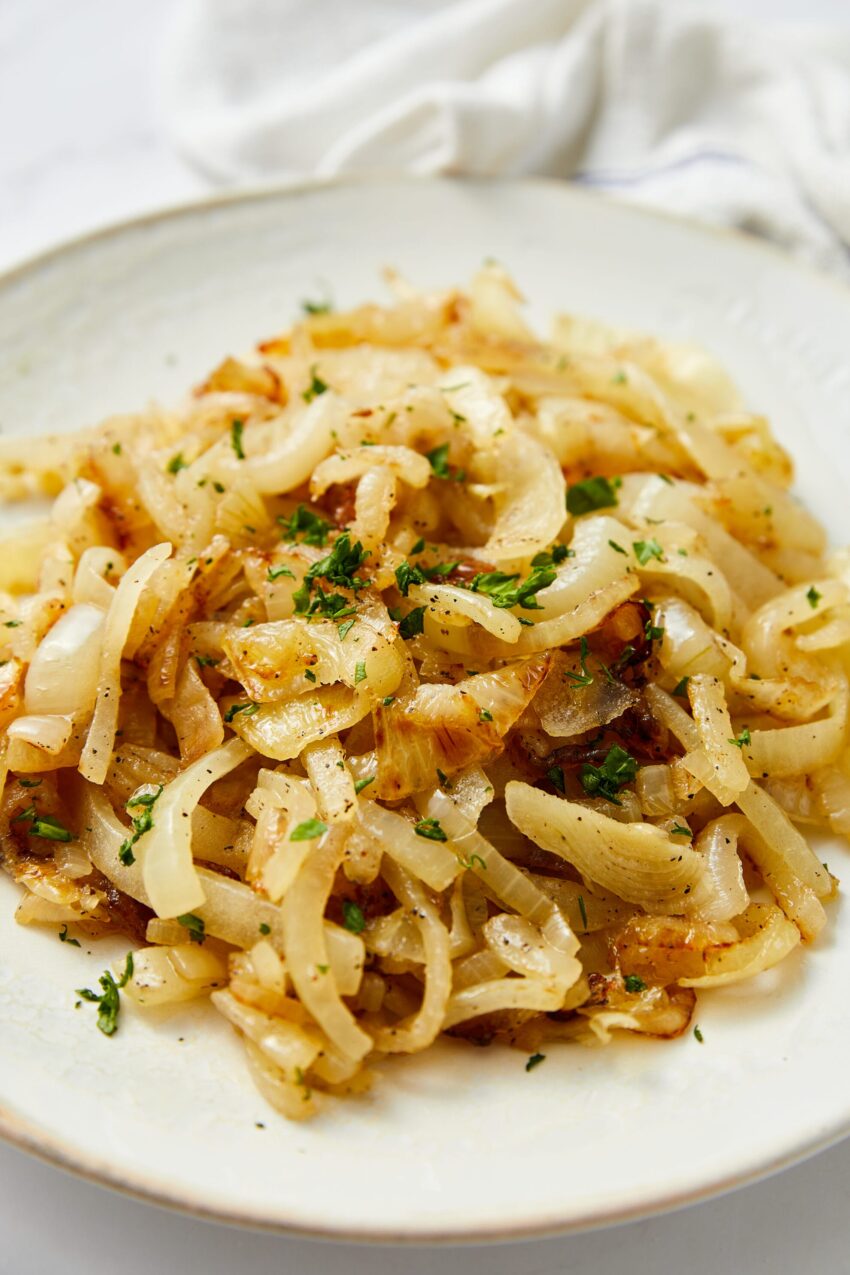Sautéed Onions

It’s incredible how a strong and bold onion becomes a sweet, soft, and delicate vegetable when sautéed.

Table of Contents
One of life’s great mysteries is understanding how a pungent onion becomes sweet perfection when sautéed. There is actually a scientific explanation. When you sauté onions, they become sweet because of the Maillard reaction and caramelization processes.
Cooking onions causes their natural sugars to break down and combine, resulting in extra flavor and a beautiful brown hue. As the onions cook, enzymes convert starches into sugars, intensifying their sweetness. This change turns that intense onion flavor into a mild taste, making sautéed onions a delightful addition to various dishes.
I may be the biggest sautéed or caramelized onion fan ever. I absolutely love them. They make the perfect topping for meats and fish, and honestly, I am happy to eat them as a side dish with anything. I find the sweetness irresistible.
This recipe uses just four simple ingredients: onions, salt, pepper, and olive oil. Maybe that is what is so intriguing about sautéed onions: they are simply onions and the most basic seasoning. Yet the result is a sophisticated, decadent side dish.
Are sautéed Onions Healthy?
Sautéed onions offer plenty of health benefits! By sautéing onions, you preserve their content while bringing out a sweet and savory flavor. Onions are rich in antioxidants, like quercetin, that can help reduce inflammation and strengthen your immune system. They also provide vitamins such as C and B6, which support skin health and energy levels. Additionally, onions are a source of fiber that aids digestion and keeps you satisfied. Cooking them with a touch of olive oil enhances their flavor and adds healthy fats to your dish.
And the best part? Sautéed onions are safe for vegans, as well as keto, gluten-free, low-carb, and dairy-free diets. Go ahead and enjoy some sautéed onions.
Why are yellow onions best for sautéing?
Yellow onions are a top choice for sautéing due to their flavor and adaptability. They offer a blend of sweetness and a hint of sharpness that becomes wonderfully mellow when cooked. Yellow onions have a higher sulfur content than other varieties, resulting in a bold taste when eaten raw but transforming into sweet and tender goodness when sautéed. They also maintain their texture under heat, while other varieties may become too mushy.
INGREDIENTS
- 3 medium yellow onions, thinly sliced
- 2 tablespoons olive oil
- 1/2 teaspoon kosher salt
- 1/4 teaspoon black pepper

INSTRUCTIONS
Prep
Peel and slice onions.
Sauté
Cook onions in olive oil with seasoning.
Serve
Enjoy as a topping or side.
Devour!

FAQs & Tips
To store your leftover sautéed onions, first bring them to room temperature. Then, place the onions in an airtight container or a food-safe plastic storage bag. They will stay fresh in your refrigerator for up to 5 days. For longer storage, keep the sautéed onions in an airtight container or a freezer-safe food storage bag in your freezer for up to 3 months.
It’s important to cut your onions as close to the same size as possible so they cook evenly. If some of your onions are large fat chunks and some are skinny little pieces, they are not going to cook for the same amount of time or get the same result. It’s hardly possible to get each onion slice the exact same size but focus on trying to get them as close to the same size as possible.
If your onions are starting to burn, it might be because the heat is too high or you’re not stirring them often. Cook the onions over medium heat, and make sure to stir them regularly so they cook evenly without getting charred. If they begin to stick to the pan, you can pour in a bit of water or broth to deglaze and stop them from burning.

Serving Suggestions
As I mentioned, I have no problem eating a bowl full of sautéed onions as a side dish. They are simply delicious. Still, there are some wonderful ways to serve them with other dishes. The classic, of course, is to top a steak (like this Instant Pot Steak) with sautéed onions. I also enjoy sautéed onions on top of a piece of fish, especially salmon. Try with this Baked Honey Cajun Salmon for instance.
If you save the leftover sautéed onions (why wouldn’t you?), grab them out of the refrigerator or freezer and add them to your soups and casseroles. They mix in easily and add loads of flavor. I especially enjoy them in Chicken No Noodle Soup or with an Easy Broccoli Cheese Casserole.


Sautéed Onions
Ingredients
- 3 medium yellow onions thinly sliced
- 2 tablespoons olive oil
- 1/2 teaspoon kosher salt
- 1/4 teaspoon black pepper
Instructions
- Peel and thinly slice the onions.

- Heat olive oil in a large skillet over medium heat until shimmering.

- Add the onions to the skillet, sprinkle with salt and pepper, and cook, stirring occasionally, until onions are golden and soft, about 15 minutes.

Nutrition
The post Sautéed Onions appeared first on Food Faith Fitness.





